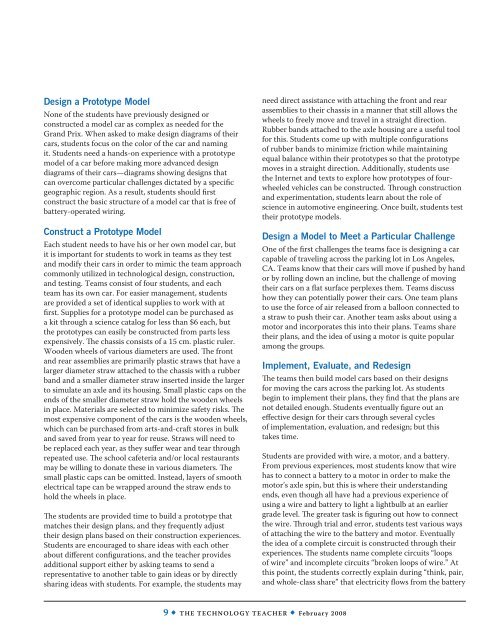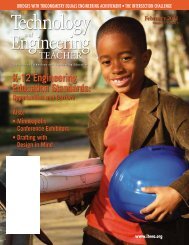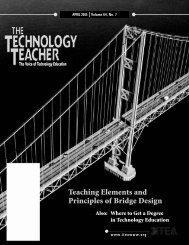Salt Lake City Conference Exhibitors Motor Mania - International ...
Salt Lake City Conference Exhibitors Motor Mania - International ...
Salt Lake City Conference Exhibitors Motor Mania - International ...
You also want an ePaper? Increase the reach of your titles
YUMPU automatically turns print PDFs into web optimized ePapers that Google loves.
Design a Prototype Model<br />
None of the students have previously designed or<br />
constructed a model car as complex as needed for the<br />
Grand Prix. When asked to make design diagrams of their<br />
cars, students focus on the color of the car and naming<br />
it. Students need a hands-on experience with a prototype<br />
model of a car before making more advanced design<br />
diagrams of their cars—diagrams showing designs that<br />
can overcome particular challenges dictated by a specific<br />
geographic region. As a result, students should first<br />
construct the basic structure of a model car that is free of<br />
battery-operated wiring.<br />
Construct a Prototype Model<br />
Each student needs to have his or her own model car, but<br />
it is important for students to work in teams as they test<br />
and modify their cars in order to mimic the team approach<br />
commonly utilized in technological design, construction,<br />
and testing. Teams consist of four students, and each<br />
team has its own car. For easier management, students<br />
are provided a set of identical supplies to work with at<br />
first. Supplies for a prototype model can be purchased as<br />
a kit through a science catalog for less than $6 each, but<br />
the prototypes can easily be constructed from parts less<br />
expensively. The chassis consists of a 15 cm. plastic ruler.<br />
Wooden wheels of various diameters are used. The front<br />
and rear assemblies are primarily plastic straws that have a<br />
larger diameter straw attached to the chassis with a rubber<br />
band and a smaller diameter straw inserted inside the larger<br />
to simulate an axle and its housing. Small plastic caps on the<br />
ends of the smaller diameter straw hold the wooden wheels<br />
in place. Materials are selected to minimize safety risks. The<br />
most expensive component of the cars is the wooden wheels,<br />
which can be purchased from arts-and-craft stores in bulk<br />
and saved from year to year for reuse. Straws will need to<br />
be replaced each year, as they suffer wear and tear through<br />
repeated use. The school cafeteria and/or local restaurants<br />
may be willing to donate these in various diameters. The<br />
small plastic caps can be omitted. Instead, layers of smooth<br />
electrical tape can be wrapped around the straw ends to<br />
hold the wheels in place.<br />
The students are provided time to build a prototype that<br />
matches their design plans, and they frequently adjust<br />
their design plans based on their construction experiences.<br />
Students are encouraged to share ideas with each other<br />
about different configurations, and the teacher provides<br />
additional support either by asking teams to send a<br />
representative to another table to gain ideas or by directly<br />
sharing ideas with students. For example, the students may<br />
need direct assistance with attaching the front and rear<br />
assemblies to their chassis in a manner that still allows the<br />
wheels to freely move and travel in a straight direction.<br />
Rubber bands attached to the axle housing are a useful tool<br />
for this. Students come up with multiple configurations<br />
of rubber bands to minimize friction while maintaining<br />
equal balance within their prototypes so that the prototype<br />
moves in a straight direction. Additionally, students use<br />
the Internet and texts to explore how prototypes of fourwheeled<br />
vehicles can be constructed. Through construction<br />
and experimentation, students learn about the role of<br />
science in automotive engineering. Once built, students test<br />
their prototype models.<br />
Design a Model to Meet a Particular Challenge<br />
One of the first challenges the teams face is designing a car<br />
capable of traveling across the parking lot in Los Angeles,<br />
CA. Teams know that their cars will move if pushed by hand<br />
or by rolling down an incline, but the challenge of moving<br />
their cars on a flat surface perplexes them. Teams discuss<br />
how they can potentially power their cars. One team plans<br />
to use the force of air released from a balloon connected to<br />
a straw to push their car. Another team asks about using a<br />
motor and incorporates this into their plans. Teams share<br />
their plans, and the idea of using a motor is quite popular<br />
among the groups.<br />
Implement, Evaluate, and Redesign<br />
The teams then build model cars based on their designs<br />
for moving the cars across the parking lot. As students<br />
begin to implement their plans, they find that the plans are<br />
not detailed enough. Students eventually figure out an<br />
effective design for their cars through several cycles<br />
of implementation, evaluation, and redesign; but this<br />
takes time.<br />
Students are provided with wire, a motor, and a battery.<br />
From previous experiences, most students know that wire<br />
has to connect a battery to a motor in order to make the<br />
motor’s axle spin, but this is where their understanding<br />
ends, even though all have had a previous experience of<br />
using a wire and battery to light a lightbulb at an earlier<br />
grade level. The greater task is figuring out how to connect<br />
the wire. Through trial and error, students test various ways<br />
of attaching the wire to the battery and motor. Eventually<br />
the idea of a complete circuit is constructed through their<br />
experiences. The students name complete circuits “loops<br />
of wire” and incomplete circuits “broken loops of wire.” At<br />
this point, the students correctly explain during “think, pair,<br />
and whole-class share” that electricity flows from the battery<br />
9 • The Technology Teacher • February 2008
















